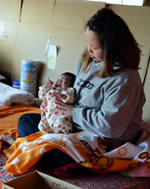



[TOKYO, Japan, 6 April 2011]
Today, in order to better promote breast-feeding in the disaster area, the UNICEF Tokyo Office, Japan Liaison Council of Breastfeeding Organizations and Special Committee for Supporting Mothers and Children Under the Stress of Natural Disasters jointly released the Declaration supporting safe and proper infant nutrition* and the Policy regarding infant nutrition during times of disaster** (see below). There are also plans to launch a free hotline in the near future that will provide guidance regarding infant nourishment and breast-feeding.
 |
| © Japan Committee for UNICEF/2011/k.shindo |
During disasters like the one in northeastern Japan, there are cases where even if a mother wants to continue breast-feeding her baby, she is temporarily unable to produce sufficient milk due to stress or shock. There is also the problem of mothers not being able to receive sufficient amounts of food and water, as well as issues related to the difficulty of securing the privacy to breast-feed comfortably. However, if mothers continue to breast-feed their babies at a more frequent pace than normal, the mother’s condition often returns to normal. Moreover, it is possible to continue breast-feeding if adequate assistance and consideration are provided to mothers and infants.
Milk contains nutrients and antibodies that infants need, protecting infants from illnesses such as diarrhea and respiratory infections. Moreover, due to the physical contact involved between the mother and baby when breast-feeding, it is also serves as a form of psychological assistance for infants. Mothers should continue to breast-feed whenever your baby asks. If a mother is able to confirm that their baby is drinking a sufficient level of breast milk by the amount of their urine and bowel movements, there is no need to supplement using powered milk.
 |
Mothers and infants that continue breast-feeding are both vulnerable, and require the understanding and assistance of those around them. (For more details, see the Declaration supporting safe and proper infant nutrition).
| ・ | Give priority to mothers that are breast-feeding when supplying food and water. |
| ・ | Prepare an environment that ensures privacy where mothers can comfortably give milk to their infants. |
| ・ | Pay consideration so that mothers and their infants are able to spend time together. |
In addition, when using powered milk make sure to prepare a sanitary environment, such as by sterilizing containers with hot water. If it is difficult to keep the baby bottle’s nipple clean, use a substitute such as a disposable paper cup to feed the baby.
| Receiving Prefecture |
Type of Emergency Supplies |
Arrival Date |
Quantity | Donating Company |
Comments |
|---|---|---|---|---|---|
| Miyagi | Water | 19 Mar. | 12,288 bottles |
VanaH Co., Ltd. | Two-liter plastic bottles |
| Fukushima | Water | 22 Mar. | 12,672 bottles |
VanaH Co., Ltd. | Two-liter plastic bottles |
| Miyagi | Underwear for boys and girls | 22 Mar. | 200,000 | ||
| Iwate | Underwear for boys and girls | 23 Mar. | 30,000 | ||
| Fukushima | Water | 23 Mar. | 4,680 bottles |
KIRIN MC DANONE WATERS Co., Ltd. | Two-liter plastic bottles |
| Miyagi | Children’s shoes | 23 Mar. | 10,000 pairs |
||
| Miyagi | RChildren’s diapers | 24 Mar. | 80 packs | P&G Japan | |
| Iwate | Children’s underwear | 24 Mar. | 9,700 | ||
| Fukushima | Water | 24 Mar. | 12,288 bottles |
VanaH Co., Ltd. | Two-liter plastic bottles |
| Iwate | Shoes | 26 Mar | 1,404 pairs | Achilles Corporation | |
| Iwate | Underwear for boys and girls | 27 Mar. | 28,266 | ||
| Iwate | Boots | 27 Mar. | 7,462 pairs | ||
| Iwate | Wipes | 28 Mar. | 1,200 | P&G Japan | For babies |
| Miyagi | Recreation kits Early Childhood Development kits |
2 Apr. | 50 of each | Procured from the UNICEF Supply Division | |
| Iwate | Recreation kits Early Childhood Development kits |
2 Apr. | 50 of each | Procured from the UNICEF Supply Division |
*In certain cases some supplies may be taken from prefectural supply storage warehouses and distributed to shelters and disaster sites in other prefectures.
As of 9:00 a.m. on 4 April 2011 (compiled by the Information and Public Affairs Division).